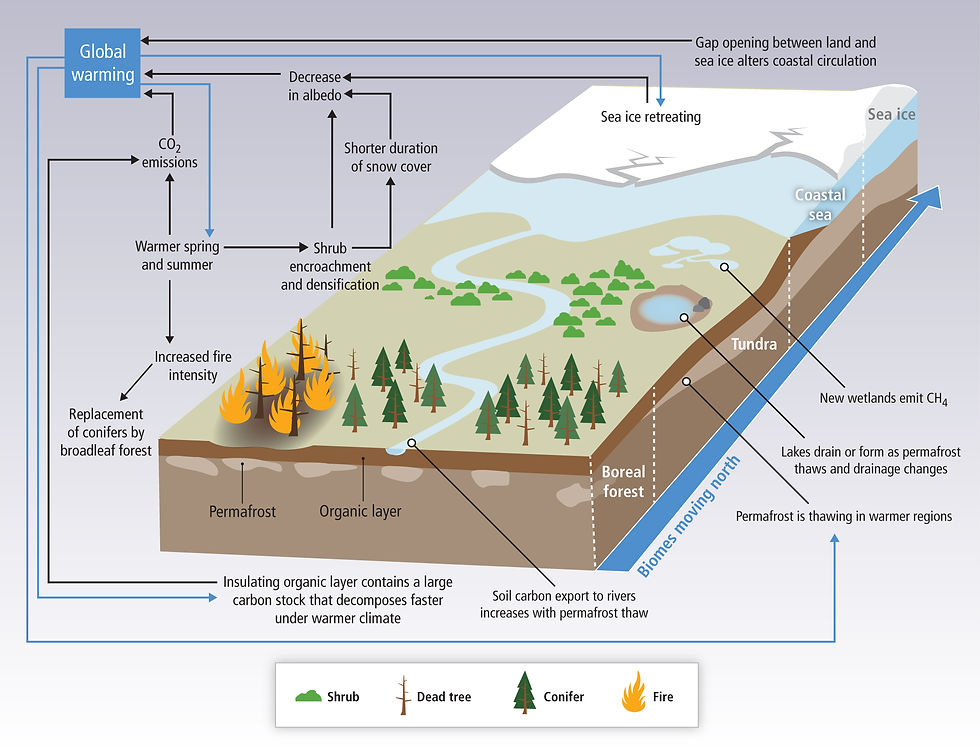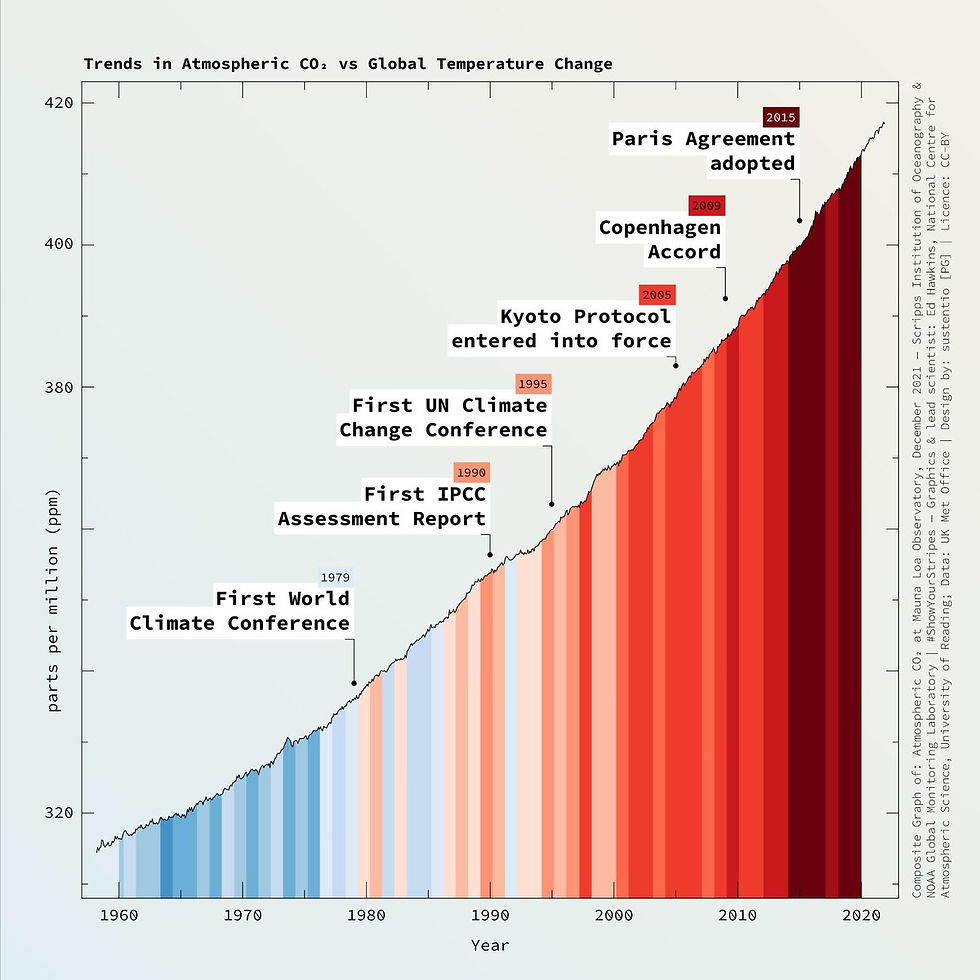Climate Change
- Edgewater Environmental Coalition
- Feb 20, 2022
- 7 min read
Updated: Jan 18, 2024
Both weather and climate describe the state of Earth’s atmosphere, just over different time scales: weather is what occurs day-to-day, while climate is the average over many years. “Climate change" refers to long-term shifts in average weather patterns for a given place (temperature, precipitation, humidity, or wind). Changes in Earth’s climate observed include:
The global average temperature has warmed about 1.2ºC (2.2ºF) since 1900, and the 10 warmest years on record have all occurred since 2005.
The extra heat has caused significant melting of glaciers and sea ice, which has in turn contributed to rising sea levels: 8 feet and counting!
Higher temps have also intensified the water cycle, resulting in more intense rainfall, drought, and increased frequency in extreme weather events.
More destructive wildfires, warmer lakes and streams, and increasing ocean acidity have destabilized ecosystems, which threatened the many plant, animal, and the human populations that depend on them.
More than 30 years ago, James Hansen warned Congress about the dangers of global warming; since then, overwhelming scientific evidence has confirmed that climate change is happening now in all parts of the world at an increasing rate.

Chicago’s climate is changing too. Average annual temperatures have increased by more than 0.8ºC (1.5ºF) since 1895, and the rate of change has accelerated in recent decades. Over this same period, total annual precipitation has increased by 15% while the rate of heavy precipitation events have increased by 40%. Lake Michigan’s warming water has led to reduced winter ice cover and increased coastal erosion.
Humidity? Increasing.
Flooding? More intense.
Droughts and heat waves? More frequent.
It’s reasonable to wonder: What’s causing all this?
Over the past century, climate change has been (primarily) driven by humans burning fossil fuels (oil, gas, and coal) for energy to power our homes, transportation, and industries. This produces “greenhouse gasses” (GHG), such as carbon dioxide and methane, that accumulate in the Earth’s atmosphere and trap increasing amounts of heat from the sun. Simultaneously, changes in land use for agriculture and housing — particularly deforestation to make space for cropland — have reduced natural ecosystems’ capacity for absorbing carbon back from the atmosphere. Though the climate varies naturally (think: El Niño / La Niña), the current rate and degree of change is unprecedented. Such shifts have not been witnessed in hundreds of thousands of years, and have been unambiguously attributed to anthropogenic (human) causes.

Let’s consider a specific example in Chicago! According to the City’s 2017 Greenhouse Gas Inventory Report, the sum total of “community activities” within city boundaries in 2017 resulted in about 31 million metric tonnes of CO2-equivalent emissions (MMTCO2e). This is slightly down from a peak of 36.2 MMTCO2e in 2005, but it is still notably greater than zero. Of these emissions, 69% were attributed to “stationary energy”: energy consumption and direct combustion of fossil fuels (mostly gas) for residential and commercial buildings, as well as industry. Transportation (planes, trains, and especially automobiles) generated 24% of emissions, while waste (mostly solid waste disposal) generated another 7%. According to the 2020 Chicago Region Tree Census, the percentage of surface area covered by trees in Chicago decreased from 19% in 2010 to 16% in 2020 - this was driven by a major loss of mature ash trees. This means that our urban canopy is sequestering less carbon, absorbing less stormwater, and blocking less daytime heat, thereby exacerbating the climate crisis in our city.
The impacts of climate change are already being felt around the world, and they’re expected to intensify as global temperatures further increase. The American West’s ongoing “megadrought” is now considered to be the worst in 1200 years. Meanwhile, extreme rainfall caused unprecedented flooding in parts of Europe. The Pacific Northwest and Western Canada experienced a record-shattering heat wave. Just months before, Texas experienced record cold brought south by a polar vortex destabilized by climate change. Australia’s Great Barrier Reef continues to experience more frequent and extensive “mass bleaching” events. Deforestation in the Brazilian Amazon has gotten so bad that it’s become a net emitter of carbon rather than a carbon sink. Recently, it was discovered that a massive glacier in Antarctica is at risk of collapse, and it alone could raise sea levels by two feet.
Climate change is also felt here in the Midwest. Increasing temps have led to worsening air quality and heat stress, increasing precipitation has led to more frequent, damaging floods and degraded water quality. These environmental stressors are expected to reduce agricultural yields by mid-century and so on.

Scientists project that environmental outcomes will continue to get worse unless we take action to prevent them. Humanity already has the knowledge and tools necessary to prevent the worst of climate change, but we lack the sociopolitical will to act with sufficient urgency. Fundamentally, we need to stop emitting greenhouse gasses into the atmosphere and destroying ecosystems that absorb carbon from the atmosphere as soon as possible - such actions are referred to as climate change “mitigation”.
There are many paths to achieving these ends. The important thing is this: We should be doing everything - not just the “best” things - as long as they move us meaningfully closer to the goal in a sustainable, equitable manner. Collective action is key.
Governments, companies, and organizations are best equipped to implement many mitigation strategies that require top-down, systemic change:
Shift energy production entirely from fossil fuel-based to clean, renewable sources, including on- and off-shore wind, large-scale solar photovoltaic, geothermal, and yes, even nuclear. A clean energy grid would significantly reduce total GHG emissions on its own; it would also make other solutions more effective.
Fully electrify and increase energy efficiency of buildings through better insulation, LED lighting, clean cookstoves, heat pumps for heating and cooling, and rooftop solar. This reduces demand for energy from the grid, making it easier to generate enough from renewable sources alone.
Reduce demand for fossil-fueled transportation — or replace it with sustainable alternatives — by expanding public transit and bicycling infrastructure, adopting and incentivizing electric vehicles, and making ocean shipping and aviation more efficient. This further diminishes the need for fossil fuels and goes hand-in-hand with a clean energy grid.
Protect and restore tropical / temperature forest, peatland, and grassland ecosystems, which act as natural carbon sinks that “sequester” carbon out of the atmosphere. At the same time, reform agriculture and forestry to use less land more productively through sustainable methods like silvopasture, managed grazing, and conservation agriculture.
Reduce waste, especially food waste, through expanded recycling and composting programs, converting waste into energy, and tighter regulations for low-flow fixtures. Avoiding unnecessary consumption — and repurposing everything else — puts less strain on limited resources, and lets us do more with less.
Individuals can also play a critical role in mitigating climate change, if only by supporting and participating in the collective mitigation actions described above:
Electrify your current home, and make it more efficient, with a retrofit; if building a new home, make it net-zero from the get-go. It’s okay to do this piece-by-piece: For example, next time you buy an appliance, choose an efficient, electric option like a heat pump or induction range over fossil-fueled alternatives.
Prefer to walk, bike, scoot, or take public transit when traveling around the city; if you need your own vehicle, buy electric — and consider carpooling. When traveling longer distances, take a train instead of an airplane; or, if possible, skip the trip and just video conference.
Reduce your personal waste by eating more plants and less meat, and composting what you don’t eat. Consider growing your own food and/or herbs. Minimize the amount of plastic you use (plastics are derived from fossil fuels), and recycle as much of the rest as possible.
Actively support those policymakers, business leaders, and organizations pushing for more sustainable, carbon-neutral systems through your vote, your pocketbook, your endorsement, and your time. Consider personally divesting from fossil fuels. Don’t underestimate the impact of democratic and market pressures on bad actors!

Because climate change is already causing significant harm, “adaptation” is also required to respond to climate impacts and reduce the risks to social, economic, health, and environmental assets and systems. Adaptation strategies vary according to a particular domain’s hazards and vulnerabilities, but it’s typical to mix options from a few general categories:
Engineered / technological: seawalls and levees, improved storm and wastewater management, efficient irrigation and other water-saving technologies, early warning systems, passive cooling of buildings, …
Ecosystem-based: conservation and reforestation, assisted migration of species, fisheries co-management, green infrastructure like parks and a healthy urban canopy, …
Educational / informational: awareness campaigns, improved curricula and expanded access to education, hazard and vulnerability mapping, improved forecasts and systematic monitoring, participatory research, …
Policy / regulatory: disaster planning and preparedness, municipal water management programs, land rezoning, improving building standards, establishing natural protected areas, fishing/hunting quotas, insurance requirements, …
Increasing evidence suggests that adaptive action by local governments and the private sector will be particularly important moving forward. And though the preference so far has been for “incremental” approaches, it’s clear that more transformational adaptation will be required soon to keep ahead of our changing climate.
Landmark international treaties and gatherings like the Paris Agreement and COP26 have secured some progress over the years, but thus far have not been enough to “bend the curve” on global GHG emissions. Meanwhile, the U.S. Congress hasn’t passed substantive climate legislation in decades, and its 2021 attempt died in the Senate. Instead, the U.S. has relied largely on a patchwork of Executive actions and regulation enforcement (when not actively dismantling them) to push forward climate-friendly policy. This hasn’t been very effective.

In contrast, Illinois has made significant recent progress through the Climate and Equitable Jobs Act (CEJA), and is now working to fund and implement those reforms. The City of Chicago is currently pursuing — or planning to pursue — a variety of climate change mitigation and adaptation strategies. In 2008 Chicago unveiled a Climate Action Plan followed by a Sustainable Action Agenda in 2012, and it’s currently developing an updated CAP for 2022. A notable infrastructure project to reduce flooding and sewage overflows, the Tunnel and Reservoir Plan, is mostly operational as of 2017, but its cost and shortcomings make it more of a cautionary example for municipal adaptation efforts. Collectively, these initiatives are accelerating the shift to renewable energy and electric vehicles, expanding carbon-absorbing green spaces, and promoting environmental justice and resiliency, but there’s still much more to be done. To see who’s leading the charge, check out local and state politicians’ environmental records (scored by the Illinois Environmental Council, an EEC affiliate) here and here.
Climate change is a serious, growing problem, and it’s easy to become overwhelmed by the scale of the challenge, which can lead to inaction and doomerism. Don’t fall into that trap! Every bit helps — every reduction in emissions, every tenth of a degree shaved off the global trajectory, every increase in capacity to adapt. In other words, “preventing” climate change isn’t a binary outcome, it’s a spectrum of possibility. There are reasons to be hopeful, from the accelerating rate of renewable energy installation and electric vehicle adoption to increasingly ambitious national and international climate plans. But more and more urgent action is needed, now. Keep doing your best, and continue supporting others so they can do their best, too.




Comments